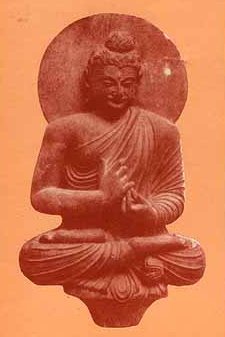Patihariya, Pāṭihāriya, Pātihāriya: 4 definitions
Introduction:
Patihariya means something in Buddhism, Pali. If you want to know the exact meaning, history, etymology or English translation of this term then check out the descriptions on this page. Add your comment or reference to a book if you want to contribute to this summary article.
In Buddhism
Theravada (major branch of Buddhism)
Source: Pali Kanon: Manual of Buddhist Terms and DoctrinesMarvel (pātihāriya).
Source: Pali Kanon: Manual of Buddhist Terms and Doctrines'miracle', marvel.
Three marvels are ascribed to the Buddha:
-
the marvel of magic (iddhi-p.),
-
the marvel of mind-reading (ādesanā-p.) and
-
the marvel of instruction (anusāsanī-p.).
In D.11, the Buddha says that he sees danger in the first two and therefore abhors them.
In A.III.61, the 'marvel of instruction' is called the one 'more noble and sublime'.
For iddhi-pātihāriya, see D.25.
See also yamakapātihāriya.
Theravāda is a major branch of Buddhism having the the Pali canon (tipitaka) as their canonical literature, which includes the vinaya-pitaka (monastic rules), the sutta-pitaka (Buddhist sermons) and the abhidhamma-pitaka (philosophy and psychology).
Languages of India and abroad
Pali-English dictionary
Source: BuddhaSasana: Concise Pali-English Dictionarypāṭihāriya : (nt.) a miracle; an extraordinary event.
Source: Sutta: The Pali Text Society's Pali-English DictionaryPāṭihāriya, (adj.) (grd. formation fr. paṭi+hṛ (paṭihāra) with usual lengthening of paṭi to pāṭi, as in °desanīya, °mokkha etc. Cp. pāṭihīra; BSk. prātihārya) striking, surprising, extraordinary, special; nt. wonder, miracle. Usually in stock phrase iddhi°, ādesanā°, anusāsanī° as the 3 marvels which characterise a Buddha with regard to his teaching (i.e. superhuman power, mind reading, giving instruction) D. I, 212; III, 3 sq.; S. IV, 290; A. I, 170; V, 327; Ps. II, 227.—Further: Vin. I, 34 (aḍḍhuḍḍha° sahassāni); Vism. 378, 390 (yamaka°); VvA. 158 (id.); PvA. 137 (id.). For yamaka-pāṭihāriya (or °hīra) see yamaka.—Two kinds of p. are given at Vism. 393, viz. pākaṭa° and apākaṭa°.—sappāṭihāriya (with ref. to the Dhamma) wonderful, extraordinary, sublime, as opposed to appāṭi° plain, ordinary, stupid M. II, 9 (where Neumann, Majjhima Nikāya II. 318 translates sa° “intelligible” and a° “incomprehensible, ” referring to Chāndogyopaniṣat I. 11, 1); D. II, 104; cp. also Windisch, Māra 71.

Pali is the language of the Tipiṭaka, which is the sacred canon of Theravāda Buddhism and contains much of the Buddha’s speech. Closeley related to Sanskrit, both languages are used interchangeably between religions.
See also (Relevant definitions)
Starts with: Patihariyakatha, Patihariyapakkha.
Ends with: Anusasanipatihariya, Iddhipatihariya, Sappatihariya, Yamaka-patihariya.
Full-text (+4): Adeshana, Patihara, Sappatihariya, Anusasana, Patihira, Patiharati, Patiharika, Samagama, Tirobhava, Anusasanipatihariya, Iddhipatihariya, Patihariyapakkha, Yamaka, Pamsukuladhovana Jataka, Lokavivarana, Anushasani, Gandamba, Pratiharya, Sundara, Pratiharakapaksha.
Relevant text
Search found 6 books and stories containing Patihariya, Pāṭihāriya, Pātihāriya, Patihāriya; (plurals include: Patihariyas, Pāṭihāriyas, Pātihāriyas, Patihāriyas). You can also click to the full overview containing English textual excerpts. Below are direct links for the most relevant articles:
The Great Chronicle of Buddhas (by Ven. Mingun Sayadaw)
Aṭṭhanga Uposatha Sīla (The Eight-Precept Observance) < [Chapter 6 - On Pāramitā]
Chapter 14 - Conversion of the Hermit Brothers and their one thousand Ascetics < [Volume 2.2]
Part 2 - The Prince’s attainment of the First Ānāpāna Jhāna < [Chapter 2 - The Performance of the Ploughing Ceremony]
A Manual of Abhidhamma (by Nārada Thera)
Summary of Functions < [Chapter III - Miscellaneous Section]
Visuddhimagga (the pah of purification) (by Ñāṇamoli Bhikkhu)
(1) The Kinds of Supernormal Power < [Chapter XII - The Supernormal Powers (iddhividha-niddesa)]
The Mahavastu (great story) (by J. J. Jones)
Chapter XXIII - Megha and Meghadatta < [Volume I]
Patipada (by Acariya Maha Boowa Ñanasampanno)
A Survey of Paramattha Dhammas (by Sujin Boriharnwanaket)